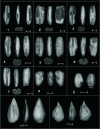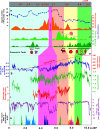9,000-year-old barley consumption in the foothills of central Asia
- PMID: 40854109
- PMCID: PMC12435284
- DOI: 10.1073/pnas.2424093122
9,000-year-old barley consumption in the foothills of central Asia
Abstract
Scholars are increasingly favoring models for the origins of agriculture that involve a protracted process of increasing interdependence within a series of mutualistic relationships between humans and plants, as opposed to a rapid single event or innovation. Nonetheless, these scholars continue to debate over when people first started foraging for grass seeds, when they began to readily utilize sickles, how prominent the early selection pressures were, and when the first traits of domestication fully introgressed into the cultivated grass population. Here, we present complementary archaeobotanical and archaeological (stone tool) evidence for cereal foragers from Toda-1 Cave in the Surkhan Darya, dating to 9200 cal BP. We conclude that early Holocene foragers were processing grains along with nuts and fruits as far north as the rich river valleys of southern Uzbekistan. These data expand the known range that preagricultural cereal foragers covered in the early Holocene, adding to our understanding of the cultural processes that led to farming. Additionally, we present the earliest evidence for people interacting with the progenitors for pistachios and apples (or a close apple relative). The complex foraging behaviors that led to cultivation were being undertaken by people during the early Holocene across a wider area of Eurasia than previously thought.
Keywords: agriculture origins; barley; central Asia; climate change; holocene.
Conflict of interest statement
Competing interests statement:The authors declare no competing interest.
Figures






References
-
- Fuller D., Lucas L., Carretero L. G., Stevens C., From intermediate economies to agriculture: Trends in wild food use, domestication and cultivation among early villages in Southwest Asia. Paléorient 44, 61–76 (2018).
-
- Weide A., Towards a socio-economic model for Southwest Asian cereal domestication. Agronomy 11, 2432 (2021).
-
- Jones G., et al. , The origins of agriculture: Intentions and consequences. J. Archaeol. Sci. 125, 105290 (2021).
Publication types
MeSH terms
Grants and funding
LinkOut - more resources
Full Text Sources

